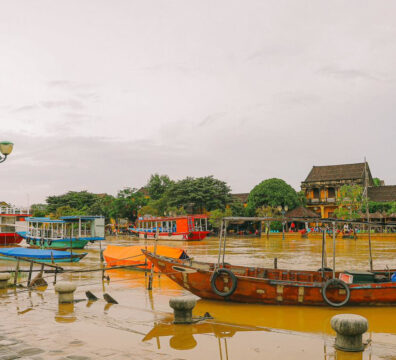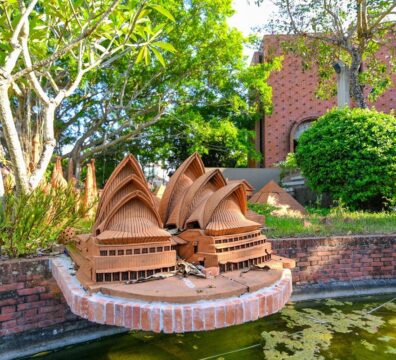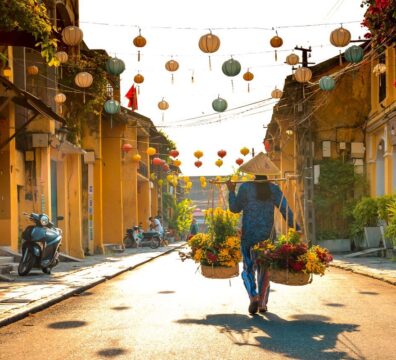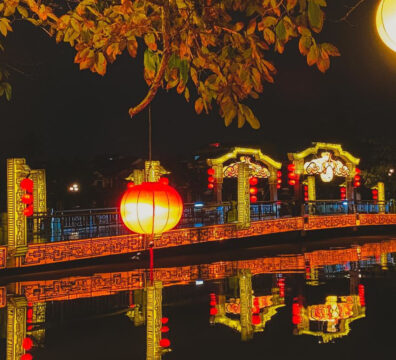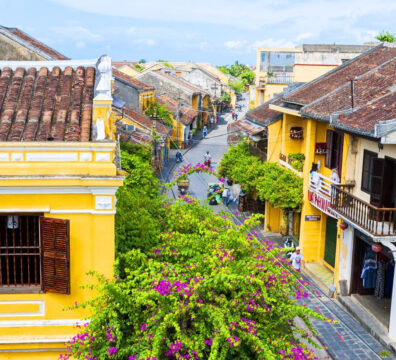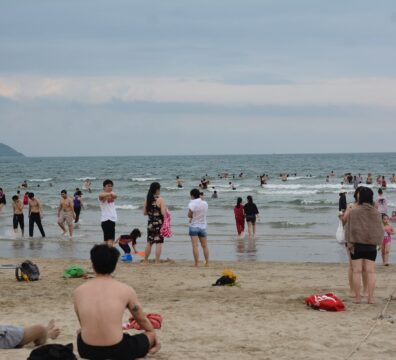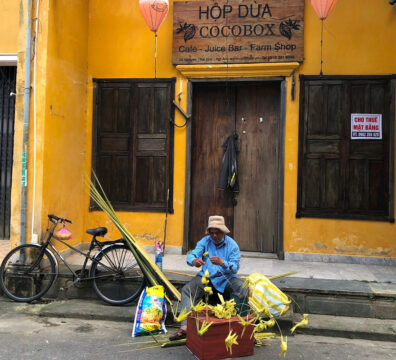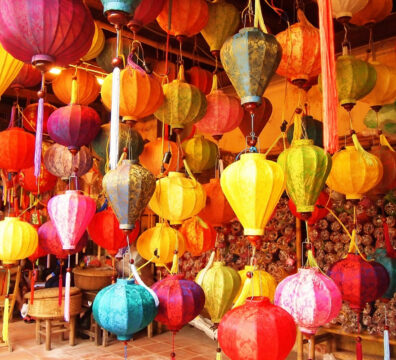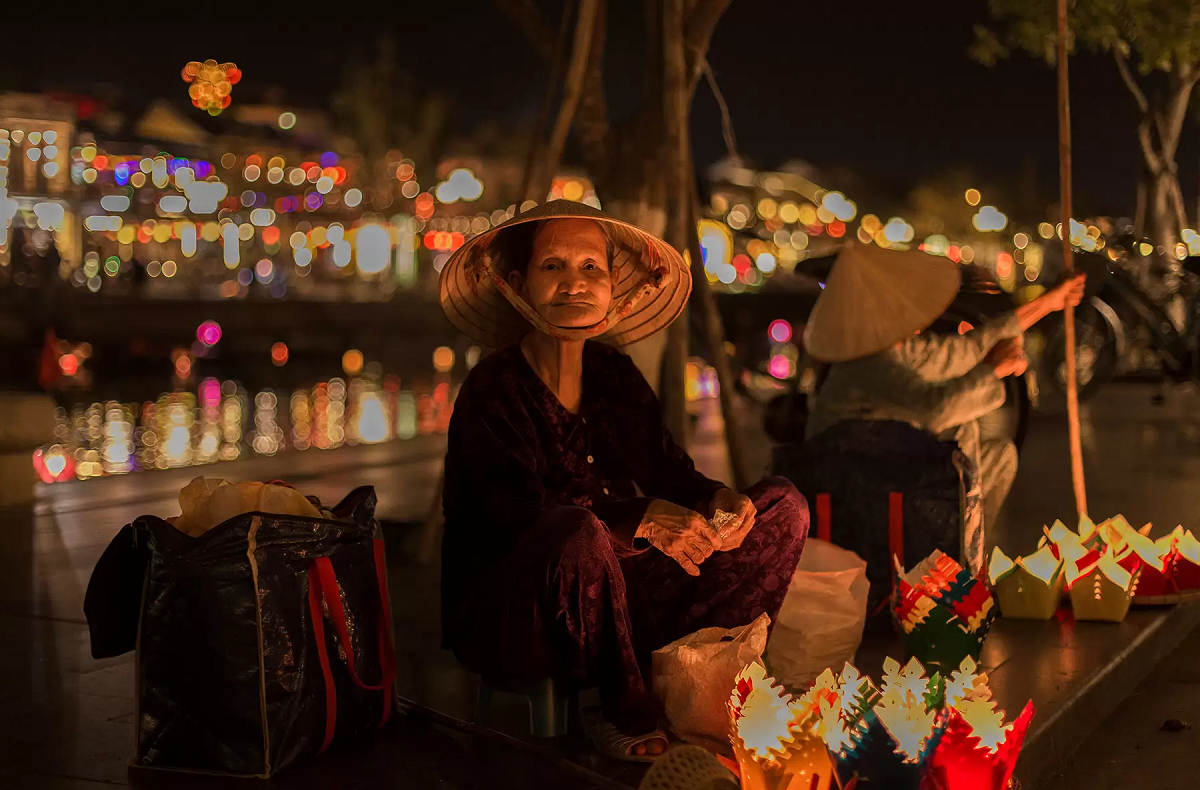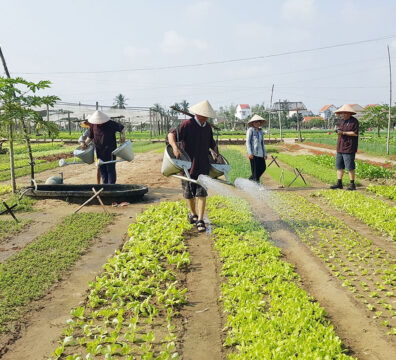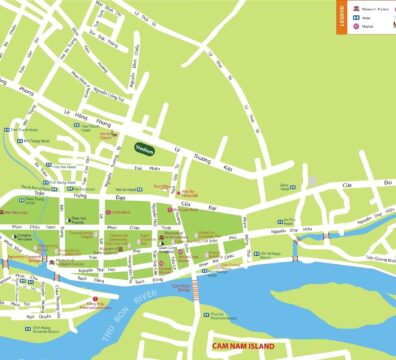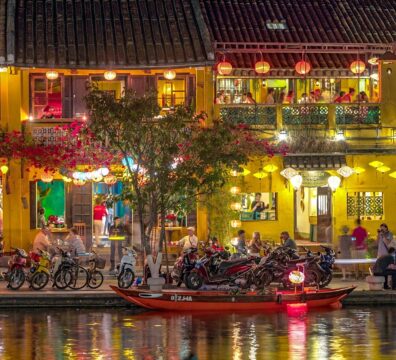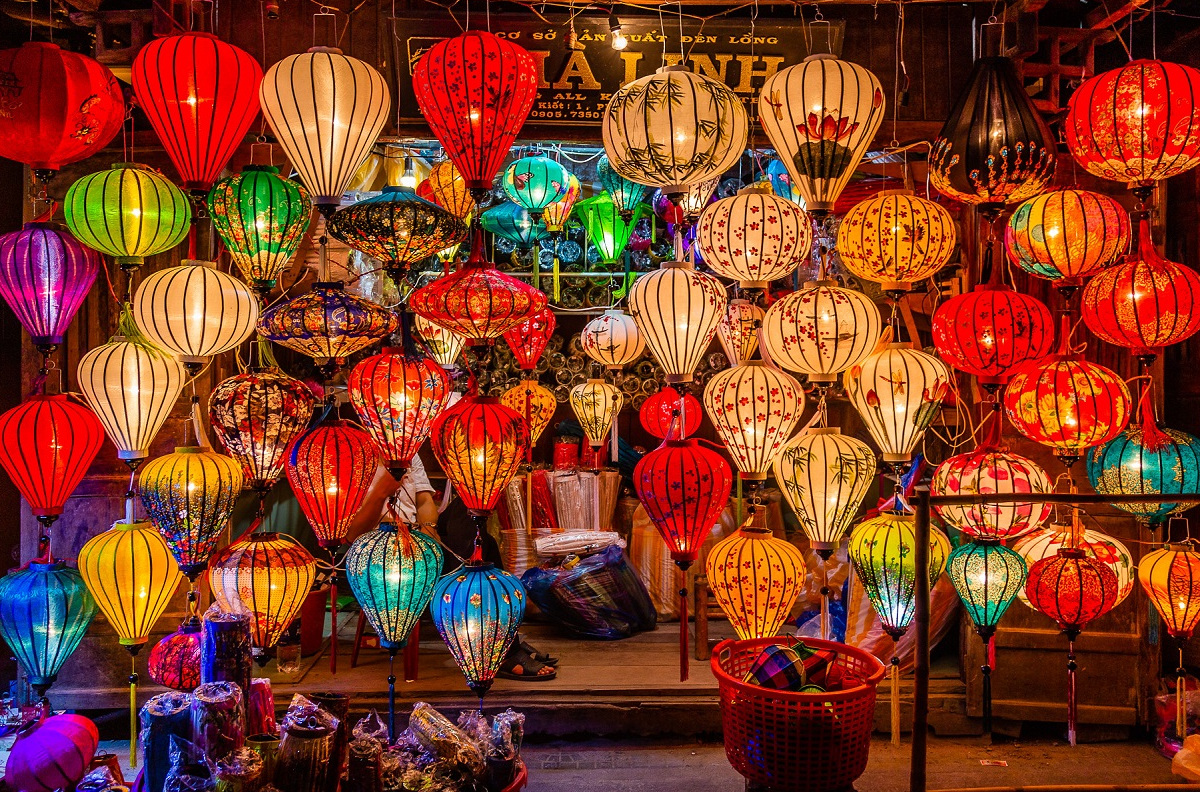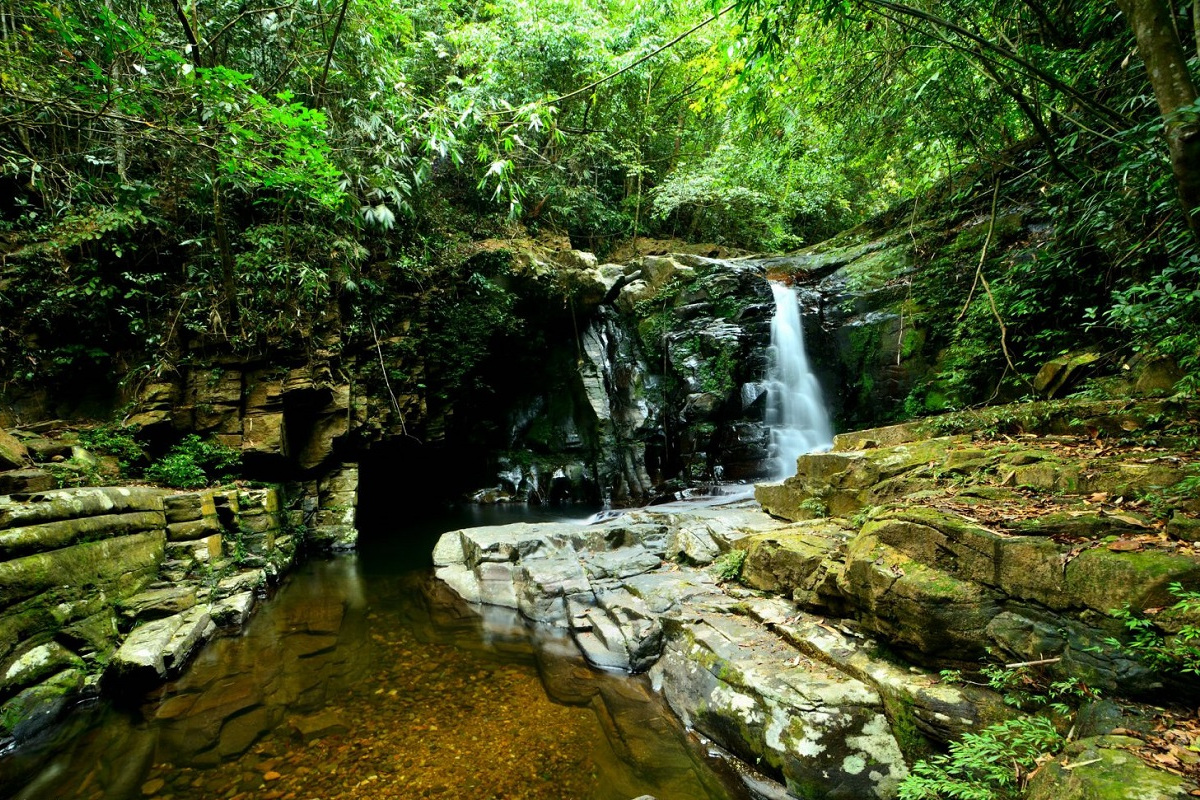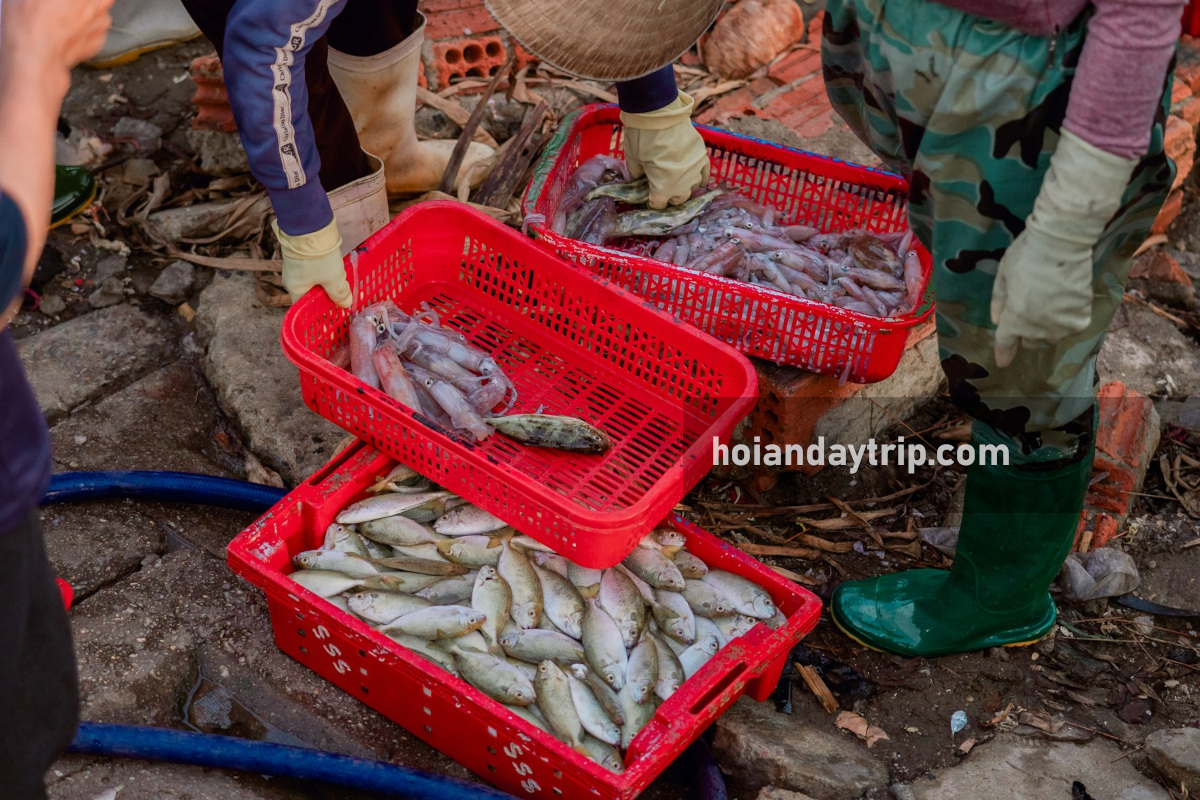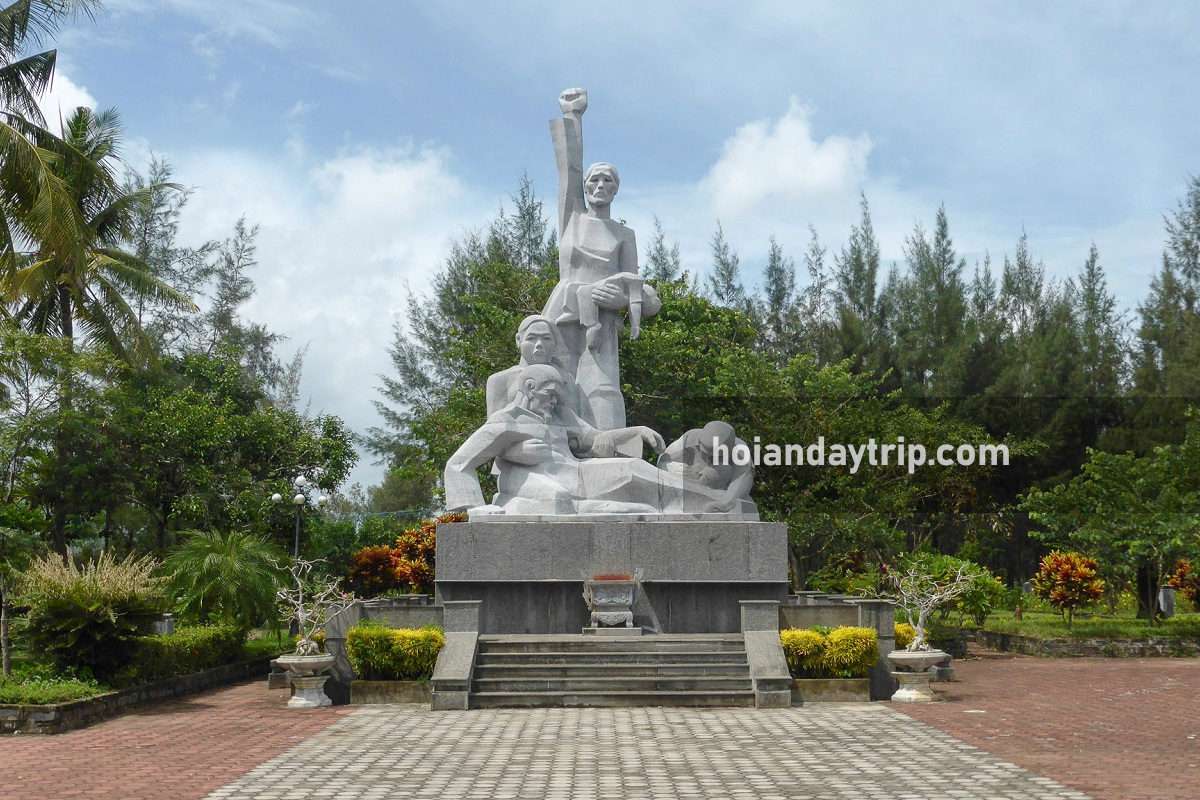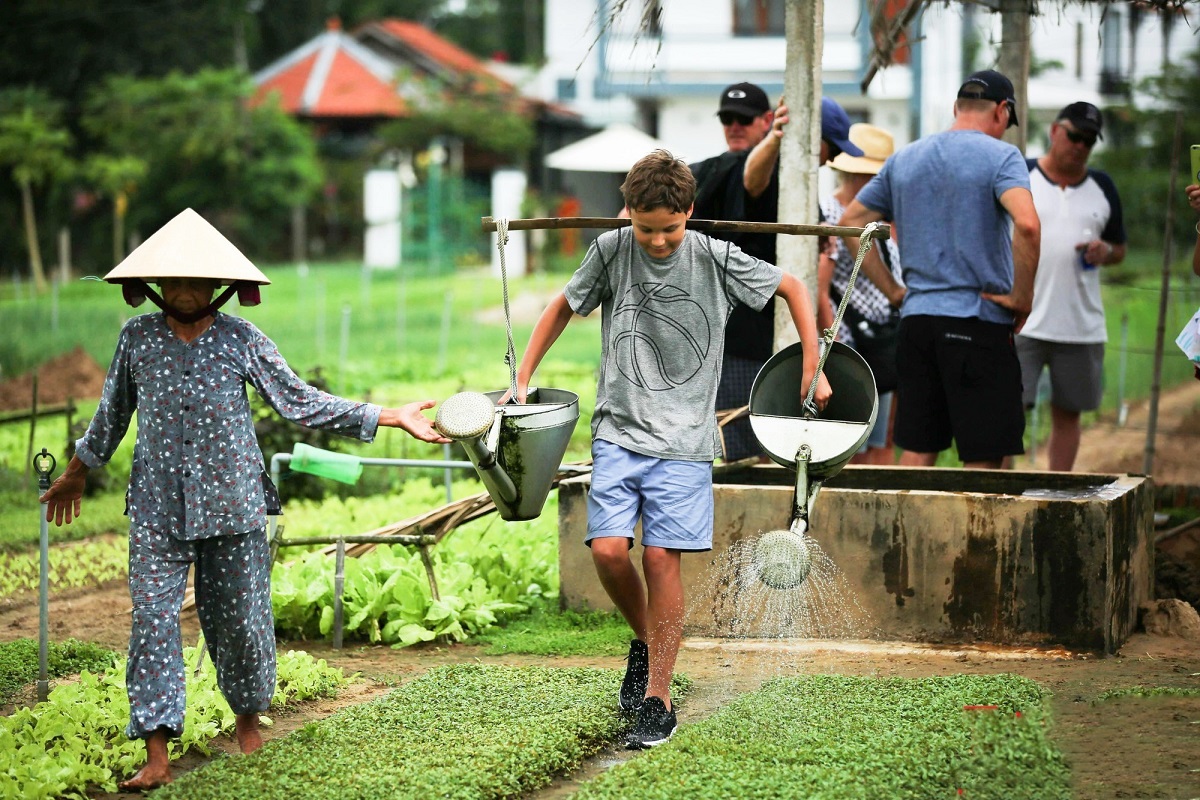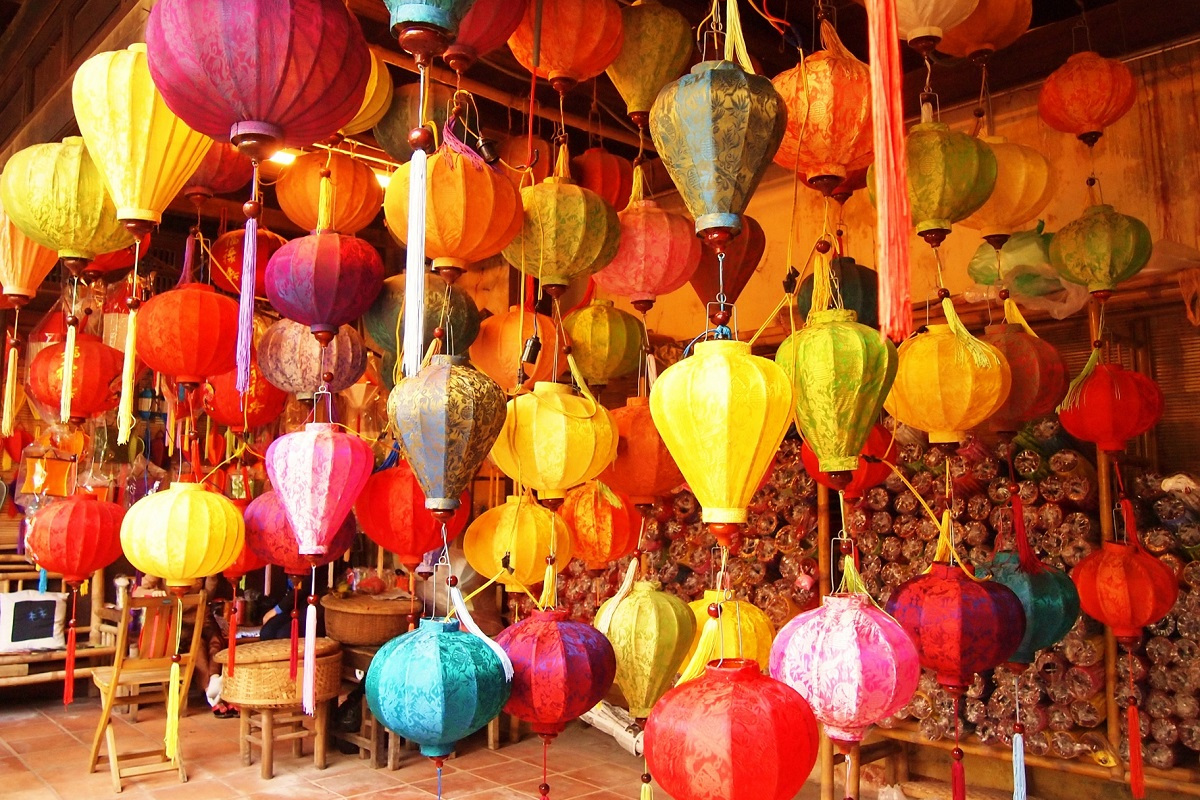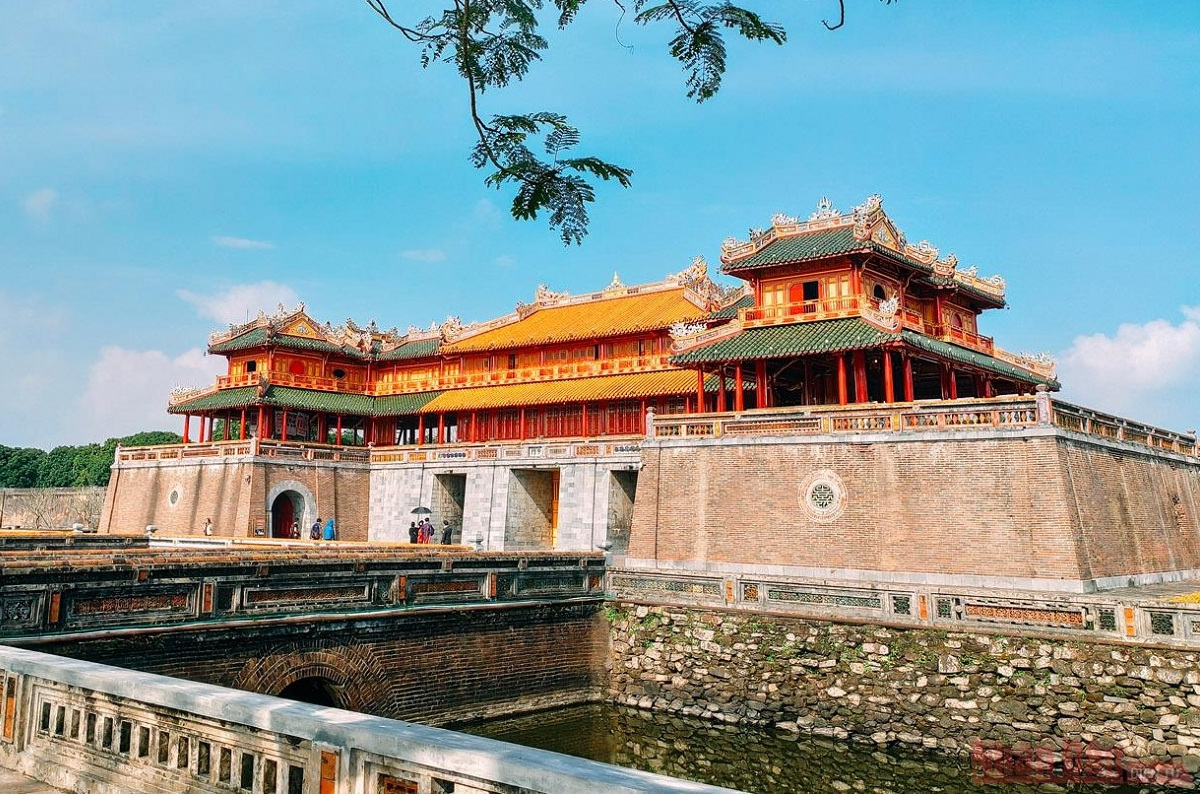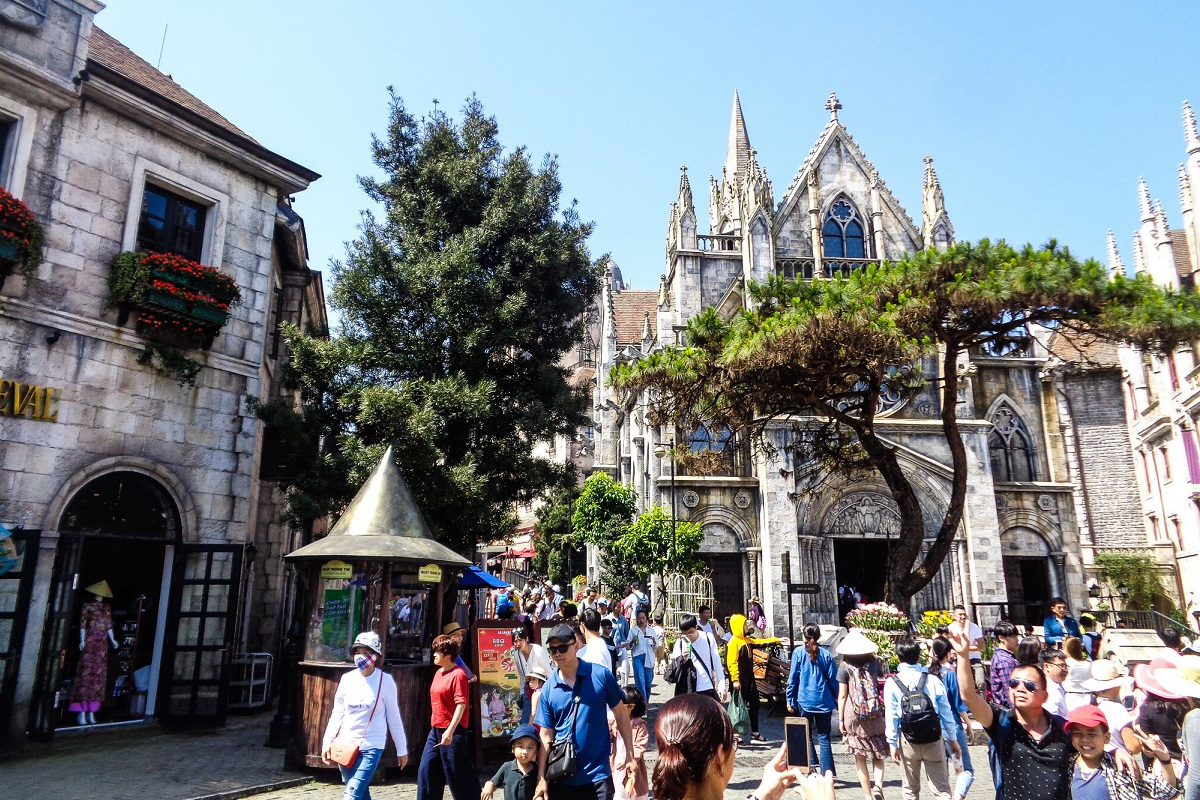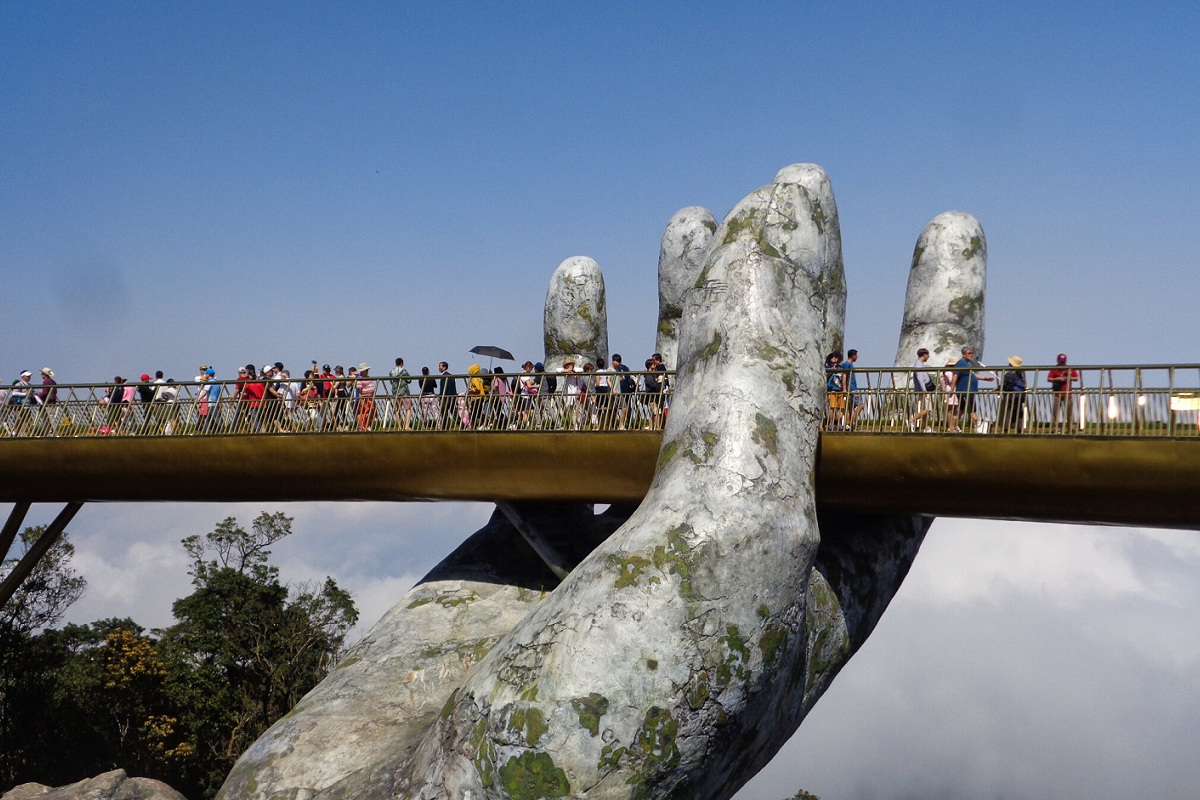Hoi An used to be a bustling, prosperous trade port during past centuries, before its role was replaced by Da Nang. Merchants from many countries on different continents came here to seek silk, spices and handicraft products including porcelain and potteries. Off the coast of Hoi An (the Cham Island), archaeologists discovered a shipwreck that contains plenty of export vases, bowls and more. The bulk of them was baked in Chu Đậu village in the north and Thanh Ha village in Hoi An. This collection then was divided into smaller ones, and sent to exhibit in leading museums throughout the country. In town, the Museum of Trade Ceramics provides the chance.
This travel guide aims to introduce Thanh Ha Pottery Village and its traditional pottery production from past to now. It’s only massive kiln in the Central region and has a slight competition with Phước Tích village in the northernmost of Hue. In the busiest year, it is the destination of 2,5 million visitors and two third is foreigners. No matter which nationality, people come here to learn about the history of local traditional handicraft and make a clay object by their own hands.
Read also:

Table of content
- 1 What is Thanh Ha Pottery Village?
- 2 Location and Get to Thanh Ha Pottery Village
- 3 Thanh Ha Pottery Village History
- 4 About Thanh Ha Village Potteries
- 5 Thanh Ha Pottery Village Entrance Fee
- 6 Activities in Thanh Ha Pottery Village
- 7 When to Visit Thanh Ha Pottery Village
- 8 Thanh Ha Terracotta Park
- 9 Thanh Ha Fish Market
- 10 Thanh Ha Pottery Village Tour
- 11 Hoi An Private Tour Guide
- 12 Thanh Ha Pottery Village on Google Maps
- 13 Related Posts
- 14 Bach Ma National Park: Hiking, Trekking in Da Nang and Hoi An
- 15 Hoi An Wet Season: What to Do in Hoi An When It Rains?
- 16 Thanh Ha Terracotta Park
- 17 Vinwonders Nam Hoi An Theme Park (formerly Vinpearl Nam Hoi An)
- 18 Am Phu Cave (Hell Cave) – Things to Do in Da Nang
- 19 Hoi An or Hue: Which is Better?
- 20 The Official Hoi An Travel Guide (MUST READ)
- 21 The Hoi An Market (Hoi An Central Market) Complete Guide
- 22 Hoi An Memories Show: The Best of Hoi An Impression Theme Park
- 23 Hoi An Bridge: Famous Bridges in Hoi An
- 24 How to Get From Hoi An to My Son Sanctuary
- 25 Hoi An’s Chinese Assembly Halls and Chinese Temples
- 26 Hoi An Walking Tours: Heritage, Foods, Photography & Locals
- 27 Hoi An Self Guided Walking Tour – Hoi An On Your Own
- 28 How to Visit Golden Bridge Vietnam
- 29 Unique Experiences in Hoi An and Why?
- 30 An Bang Beach: A Guide to Hoi An’s Best Beach
- 31 Experiences in Hoi An: Get Insight Into Hoi An’s Local Culture
- 32 Things to Do in Ba Na Hills Besides Golden Bridge
- 33 Hoi An Nightlife: What to Do in Hoi An At Night?
- 34 Hoi An Countryside: Villages, Rice Fields & Tours
- 35 How to Get to Golden Bridge From Hoi An
- 36 Hoi An Entrance Fee: Old Town, Golden Bridge, My Son, More
- 37 Hoi An Airport: Everything You Need to Know
- 38 Hoi An Lantern Boat Ride on Hoai River
- 39 Hoi An Private Car and Driver
- 40 What to Do in Hoi An Ancient Town
- 41 Da Nang and Hoi An Itinerary for Visitors Staying Overnight in Hoi An
- 42 Hoi An 3 Day Itinerary: A Travel Plan for 3 Days in Hoi An
- 43 Hoi An Free Things to Do: Budget Travel in Hoi An Vietnam
- 44 Hoi An One Day Itinerary: A Travel Plan for One Day in Hoi An
- 45 Hoi An Half-Day Tours: Guide to Half Day Trips From Hoi An
- 46 Hoi An Day Tours: A Guide to Best Day Trips From Hoi An
- 47 Hoi An Beach: A Guide to All Beaches in Hoi An Vietnam
- 48 Hoi An Food Specialties
- 49 How to Get From Hoi An to Da Nang
- 50 Hoi An Cheap Things to Do: All Solo Travelers Need to Know
- 51 Hoi An Best Things To Do: Recommendations from Local Experts
- 52 Hoi An Things to Do: All What Can You Do in Hoi An Vietnam
- 53 Hoi An Things Not to Miss: A Guide to Must Do in Hoi An
- 54 Hoi An or Da Nang: Which is Better for First Time Visitor?
- 55 Hoi An Pottery Village: A Guide to Thanh Ha Pottery Village
- 56 Hoi An Ancient Town Tour
- 57 Hoi An Old Town Ticket: Price, Sellers, Included Sites, More
- 58 My Son Sanctuary Tour
- 59 Hoi An Lanterns: Festival, Making Class, Where to Buy, More
- 60 Hoi An Best Area to Stay: Guide to Where to Stay in Hoi An
- 61 Hoi An Weather by Month: Guide to Hoi An Monthly Weather
- 62 Hoi An River Cruise: Guide to The Best Boat Tour in Hoi An
- 63 Hoi An Old Town Boats: Guide to Boat Rides in Hoi An Town
- 64 Hoi An 2 Day Itinerary: Traveler Guide to 2 Days in Hoi An
- 65 Cham Island Hoi An
- 66 Hoi An Basket Boat Ride
- 67 Hoi An Coconut Village: A Guide to Cam Thanh Coconut Village
- 68 Hoi An Cham Temples: My Son Sanctuary & Quang Nam Temples
- 69 How to Get from Da Nang Airport to Hoi An
- 70 Da Nang to Hoi An: Best Da Nang Airport Transfer and More
- 71 Hoi An Tour Guide: How to Find a Private Tour Guide in Hoi An
- 72 Hoi An Ancient Town Attractions
- 73 Hoi An Old Town Map
- 74 Tra Que Vegetable Village
- 75 Guide to Hoi An Lantern Festival – Hoi An Full Moon Festival
- 76 Hoi An Night Market: A Thing to Do in Hoi An at Night
- 77 My Son Sanctuary Travel Guide
- 78 Hoi An Old Town Unesco World Heritage – Hoi An Travel Guide
- 79 Featured Tours and Experiences
- 79.0.1 Bach Ma National Park Tour from Hue
- 79.0.2 Bach Ma National Park Tour from Da Nang/Hoi An
- 79.0.3 Hoi An Sunrise Fish Market Tour
- 79.0.4 My Lai Massacre Tour
- 79.0.5 Golden Bridge/Ba Na Hills & Hoi An Tour
- 79.0.6 Hoi An Instagram Tour
- 79.0.7 Ky Anh Tunnel & Tam Thanh Mural Village Tour
- 79.0.8 Da Nang to Hue Motorbike Tour with Hai Van Pass & Easy Rider (1 Way)
- 79.0.9 Hue to Da Nang Motorbike Tour with Hai Van Pass & Easy Ride (1 Way)
- 79.0.10 Hue to Hoi An Motorbike Tour with Hai Van Pass & Easy Rider (1 Way)
- 79.0.11 Hoi An to Hue Motorbike Tour with Hai Van Pass & Easy Rider (1 Way)
- 79.0.12 Tra Que Vegetable Village Tour with Cooking Class
- 79.0.13 Ba Na Hills Half Day Tour from Hoi An
- 79.0.14 Marble Mountain & Hoi An Day Tour from Da Nang Port
- 79.0.15 Hue Day Tour from Chan May Port with Lunch
- 79.0.16 Marble Mountain & Hoi An Tour from Chan May Port
- 79.0.17 Ba Na Hills/Golden Bridge Tour from Da Nang Port
- 79.0.18 Ba Na Hills/Golden Bridge Tour from Chan May Port
- 79.0.19 Golden Bridge Private Tour with Ba Na Hills & Lunch
- 79.0.20 Ba Na Hills Afternoon Tour with Golden Hands Bridge
- 79.0.21 Ba Na Hills Private Tour with Golden Hands Bridge
- 79.0.22 Ba Na Hills Half Day Tour with Golden Bridge
- 79.0.23 Ba Na Hills Early Morning Tour to Beat the Crowds
- 79.0.24 Golden Bridge and Ba Na Hills Night Tour
- 79.0.25 Golden Hands Bridge Tour In Sunrise or Sunset (1/2 Day)
- 79.0.26 Cam Kim Island Bicycle Tour From Hoi An
- 79.0.27 Cham Island Tour From Hoi An (Group Tour)
- 79.0.28 Cham Island Tour From Da Nang (Group Tour)
- 79.0.29 Hoi An Vegetarian Food Tour
- 79.0.30 Hoi An Evening Walking Food Tour with Local Foodie
- 79.0.31 Private Hoi An Basket Boat Tour (Shuttle Bus, Bicycle, Bike)
- 79.0.32 Half-day Am Phu Cave Tour (Private)
- 79.0.33 Hoi An Countryside Tour by Electric Car or Bike
- 79.0.34 Da Nang Tour Package From Singapore
- 79.0.35 Hoi An Evening Tour From Da Nang with Lantern Boat Ride
- 79.0.36 Hoi An Walking Food Tour Through Laneways
- 79.0.37 My Son Sanctuary and Hoi An Old Town Tour
- 79.0.38 My Son Day Trip From Hoi An including Marble Mountains and Basket Boat
- 79.0.39 Half Day Hoi An City Tour With River Cruise
- 79.0.40 Son Tra Peninsula Tour with Marble Mountains (Private/Small Group)
What is Thanh Ha Pottery Village?
Thanh Ha Pottery Village (or Làng gốm Thanh Hà) is a famous pottery making community 2,5 km to the west of Hoi An Old Town. It’s established in 16th century by Vietnamese immigrants from the north. When the town was busy with foreign merchants in later times, its inhabitants produced high-quality potteries for exportation. Thanh Ha’s clay products have their own characteristics that are unlike other “workshops” in Vietnam. Nowadays, there are 35 families continuing their ancestor handicraft tradition and creating souvenirs, building materials for sale. The artisans also guide visitors how to make ceramics by themselves. It’s an experience in which so much fun is provided.
Thanh Ha pottery making now is a national intangible cultural heritage, only in Da Nang and Hoi An area.
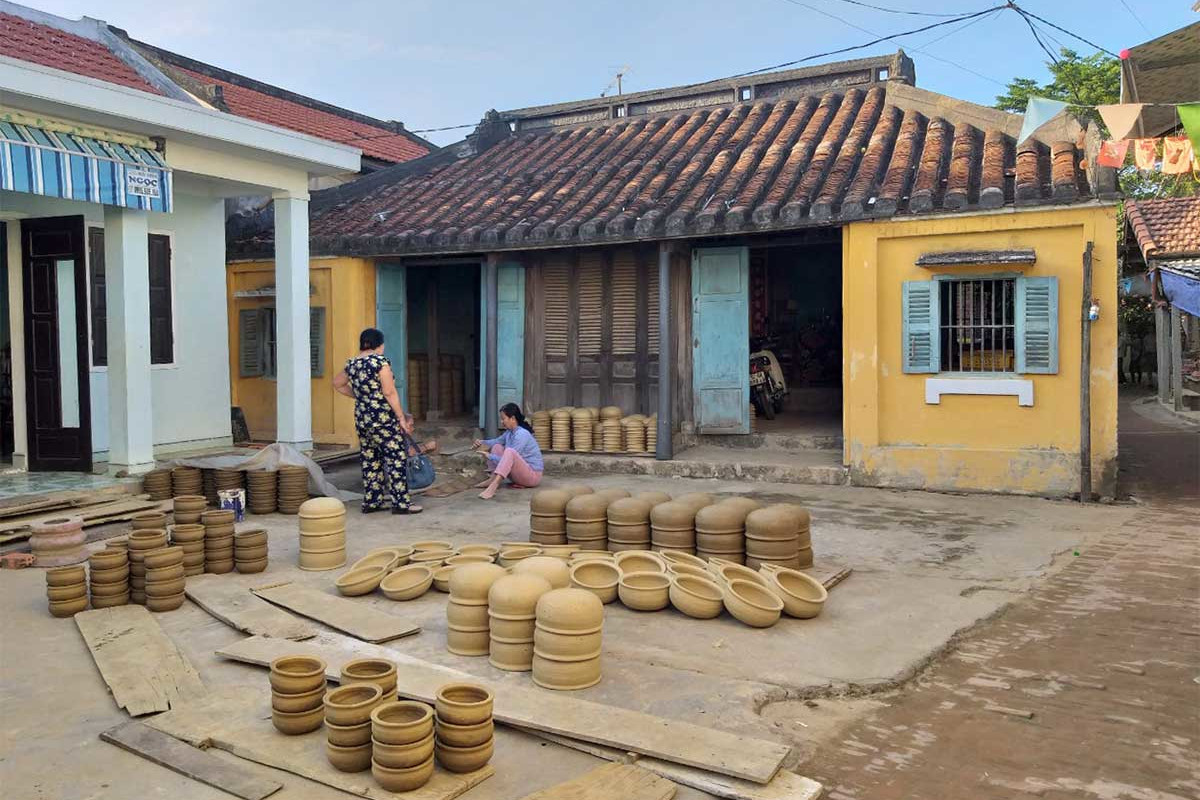
Location and Get to Thanh Ha Pottery Village
Where is Hoi An Pottery Village?
Thanh Ha Pottery Village is 3 km from the Old Town, to the west via Hung Vuong St. Pham Phan Rd and Hung Vuong Rd connect it with the busiest highway in Vietnam – QL1A, Da Nang and My Son Sanctuary. In its “entrance”, the newly-built Cam Kim bridge leads to the island of the same name where peaceful rural villages are located. To the north, Hai Muoi Tam Thang Ba Rd provides a short distance to the beaches. Thanks to being by the Thu Bon river, traveling to it by boat is possible.
Car, Bus and Bikes
Thanh Ha Pottery Village has a very convenient location that is easy to get from anywhere in Hoi An and Da Nang to it. From the Old Town, travelers need less than 10 minutes to see the ticket booth and start exploring then, by taxi or car. The main street – Duy Tan is also wide enough to allow the access of buses. Bikes definitely are okay to ride around the village. Parking in the ticket counter (5,000 VND fee) and touring by foot is recommended for motorcycle riders. If have a bicycle,
Hoi An Old Town Boat to Thanh Ha Village
Traveling by boat to Thanh Ha village from Old Town’s harbour is often recommended by local tour operators. The ride may include Kim Bong carpentry village in some packages. It’not long, around 15 minutes and provides a chance to view tranquil sceneries on the banks and enjoy cool breezes. In the sunset time, the experience is definitely nicer, with a brilliant beauty of golden river and orangish skies. Sunset ride should be from the village downstream to the town. The bicycle can be brought to the boat without an additional fee.

Thanh Ha Pottery Village History
Establishment of Thanh Ha Village
In 1602, a place near Thanh Ha village today was chosen to be capital of Quang Nam province. It’s the seat of power for Nguyen Hoang lord who moved to the south of the country at that time to establish his own state. In a dream, he saw a goddess and she gave him a clay bowl. Then, told him to go to her temple where the land around it is perfect to develop pottery production. The day after, the lord and his son rode the horse and finally found it according to her guidance. After that, he sent the soldiers to return to his hometown, to call for immigrants and especially experienced potters. The first families (founders) are 8, including Nguyễn Viết, Nguyễn Văn, Bùi, Võ, Ngụy, Nguyễn Kim, Lê and Nguyễn Đức. All have been honoured in Nam Dieu Temple today by their successors.
A fact that the current location of the village was not the first place where the founders resided. They moved to it later because of its conveniences in traffic. It’s close by major roads, between Hoi An port and the political capital, and by the largest river – Thu Bon. It’s great to off-load the materials and load complete products for sale.
Producing Potteries for Exportation
People made pottery in Thanh Ha village from mid-16th century, as a part time job to improve their income. In 17th onwards, Hoi An town nearby became a thriving trade port and attracted merchants who seeked good-quality clay products to buy. Taking this chance, locals are more active in spinning the wheel and firing the kilns. That’s the reason why the village was moved to its current location, by the river that is perfect for loading and off-loading of the goods. Local production reached its peak in the 19th century and early 20th century. Following the merchants, Thanh Ha’s potteries were presented in many countries worldwide. Then it declined due to wars and increasing popularity of plastic and metal objects. In the 1980s, villagers changed to make tiles and bricks, and in the 1990s, they invented clay whistles to sell for tourists. Fine art and glazed ceramics are also manufactured.
Tradition of Making Potteries Today
Nowadays, there are 35 families still producing potteries in the village, the holders of the national intangible cultural heritage title. The artisans are 15th and 16th generations of the founders who migrated from two Northern provinces – Nghe An and Thanh Hoa. Apart from pottery, people here also make tiles and bricks as building materials to reconstruct and renovate ancient houses in the Old Town. As a result of tourism growth in recent years, souvenirs, gifts and other lovely things are seen around. On the other hand, the tradition is partially shared to visitors who like to create their first potteries ever in their lifetime. Artisans will instruct from the scratch if requested.


About Thanh Ha Village Potteries
The Material
The material used to make Thanh Ha potteries has to be yellow, flexible clay with a high adhesion. In past centuries, the villagers could extract it in the village or the surrounding rice paddies. Today, they buy the soil from Thanh Quýt (11km northwest) or Thi Lai (15km southwest). The sellers often move by boat to the village.
How to Make a Pottery in Thanh Ha Village
The first stage to make potteries in Thanh Ha is to process the soil into the clay. After adding water, the makers use the trowel to trim and cut the soil into smaller pieces. They knead each piece 3 times until becoming perfect for the next step – forming the shape. In common, two people (maybe husband and wife) do it to produce the potteries quicker, but now solo makers are seen more popularly. He or she uses a manual pottery’s wheel to spin and create what he/she likes, such as a pot to cook food or make tea. This step requires many skills and experiences. After feeling the products are nicely shaped, people put them in the sun and the final “fitting” starts when the “crust” becomes dry. After fully dried, potteries are ready to be sold in markets or souvenir stores.
Distinctions of Thanh Ha Potteries
Thanh Ha potteries are non-glazed and fired in the wood kiln. These may be lost in many traditional villages across the country due to modernization and mass production. In the visit, travelers can see artisans drying the pots on the open yard or burning kilns.

Thanh Ha Pottery Village Entrance Fee
Price of Thanh Ha Pottery Village ticket is 35,000 VND for adults and 15,000 VND for childrens. It covers entry to the village, visiting historical sites (Nam Dieu Temple, Xuan My Communal House), a pottery making class with artisans, a gift (clay whistle) and two-way transfers from the counter.
The ticket booth is at the crossroads of Duy Tan and Pham Phan roads, the Terracotta Park. It opens daily from 8 a.m to 5:30 p.m. If traveling by boat, travelers will see a cashier in the landing place to buy tickets. The class is available in workshops, houses of the artists where it’s possible to see wheels and many potteries around. Some of them are along the riverfront. The whistle gift is received in an artisan house near G.O.M coffee. The owner of the place will give a board showing years of birth and corresponding zodiac animals in traditional thought. It’s fun to guess what animal is yours and other family member’s.
At the counter, ask the cashier to give you a map and request her to note workshops, places to get the gift and temples. Tour guide is available for free for a group of 8 people minimum.

Activities in Thanh Ha Pottery Village
Making a Pottery by own Hands
Thanh Ha Pottery Village entrance fee covers this must-do activity. It’s available in the workshops (houses of artisans) by the riverfront or in brick-paved lanes of the place. In each workshop, the owners will instruct visitors how to make their own pottery from a piece of pre-processed clay. All steps follow the tradition. He/she gives the demonstration first and then visitors start touching on the wet soil. A manual potter’s wheel is used instead of the one run by electricity. The learners can spin it by themselves or have help from artisans. While forming a pot or vase, they are also assisted to create a beautiful shape and add a spout if that is a teapot. Lastly, visitors can choose to pack and take it away immediately or let the people dry it in the sun and send it to the hotel later. In the house, there are numerous pieces of pottery to buy.
Visiting Historic Buildings
Thanh Ha Village has some historic buildings to have a look at and learn about its history and local architecture. These are the highlights:
– Xuan My Communal House: by and facing the river. Under the shaded banyan tree, it’s built in the mid-17th century, and the last (largest) renovation was in 1903. On the paved yard, there is a front screen (bình phong) and two small shrines to worship the Six Fairy Ladies and God of the Land. In the second place, a stone elephant of the Chams in 8th century is seen. Its architecture is typical of a Hoi An’s communal house where the founders are honoured. Two ceremonies are held in the year here: lễ tế xuân (the 12nd day of the second lunar month) and lễ tế thu (the 12nd day of eighth lunar month).
– Le Ban House: a garden house built in the end of 19th century, by a rich pottery seller at that time named Lê Từ. It’s the only old resilience in the village today.
– Nam Dieu Temple of Potter Ancestors: in the northernmost part of the village. It’s constructed in 1866 to honour the first pottery makers in history. On the 10th day of the first lunar month (tháng giêng), a festival takes place here.
Shopping Souvenirs
In the workshops, visitors can see lots of potteries for sale with a variety of size, shape and price. Some of them may be nice to bring home as a reminder about Hoi An. Due to direct sellers, visitors pay lower rates than in town. There are many souvenir stores around the village too.

When to Visit Thanh Ha Pottery Village
Anytime of the day it is okay to visit Thanh Ha Pottery Village and start making a clay pot by yourself. Tickets are sold from 8 a.m to 5 p.m, but if coming earlier or later, you can pay directly for the artisan to learn his/her techniques. In some workshops, you just need to buy something. Although being close by the river, floods don’t affect the village in the rainy season.
If traveling to Thanh Ha Pottery Village by boat, the best time to board from the Old Town is in the afternoon and return in the sunset. Sparkling scene of sundown on Thu Bon River is definitely a wonderful ending to the day of exploration.

Thanh Ha Terracotta Park
This is the newest cultural landmark in Thanh Ha Pottery Village. It’s built in 2011 by Nguyễn Văn Nguyên – an architect who was born in the village. He used non-glazed bricks to build that tell visitors a distinction of local potteries. The park has 2 different buildings, representing 2 styles of kiln and all stand on a potter wheel. Its exterior features ponds and flows of water, flowers and the miniature of many wonders of the world, like the Sydney opera house or Colosseum amphitheatre in Rome. Inside the buildings, visitors will see exhibitions of potteries across the country, including the ancient ones made by the Cham or Sa Huỳnh cultures.
Thanh Ha Terracotta Park opens from 8:30 a.m to 5 p.m from Monday to Friday, and from 8 am to 5 pm on weekends. Its entrance fee costs 50,000 VND for adults and 30,000 VND for children.
See full details in https://centralvietnamguide.com/thanh-ha-terracotta-park/


Thanh Ha Fish Market
This bustling fish market is under the new Cam Kim Bridge, in the “entrance” of Thanh Ha Pottery Village. It opens from around 4 a.m and ends at 7 or 8 a.m. Travelers are recommended to visit in early hours due to the chance to see the most diversity of fishes and seafoods. Scene of fishermans, their boats, sellers, and buyers is really lively. A picture here is what local photographers must have. Pottery workshops are nearly 1 km away (following Duy Tan Rd).
Thanh Ha Pottery Village Tour
Thanh Ha pottery village is in the half-day Hoi An countryside tour. Here, travelers will experience making pottery at their hands, with assistance from artisans. Definitely, family members or friends will have an interesting time with wet clay, potter’s wheel or touchings. Before that, the guide shows the village’s historical places and local life through peaceful laneways.
Two other rural villages complete the rest of the tour. The first village – Tra Que vegetable growing village is the host for a farming class. In which, travelers become farmers, interact with real farmers and learn about traditional techniques to plant baby herbs. In the second village – Cam Thanh coconut village, a local man will take travelers around a peaceful sea palm forest and watch fun-filled performances (like spinning boat ride). Also, have the chance to catch fishes or crabs like how villagers do daily.
Text us in whatsapp number +84968009827 for further details and make a reservation.
Hoi An Private Tour Guide
Hoi An and lots of nearby attractions have a rich history and a strong link to local culture and religion. Two Unesco world heritage sites are no exception. So, traveling with a tour guide is suitable to open traveler’s horizons about places they set foot on. The best trip is with a guide that he/she is knowledgeable and fluent in the preferred language(s). Reading our article for How to Find a Private Tour Guide in Hoi An for further information.
Text us in whatsapp number +84968009827 if seeking a knowledgeable and English-speaking guide in Hoi An.
Thanh Ha Pottery Village on Google Maps
Related Posts
Bach Ma National Park: Hiking, Trekking in Da Nang and Hoi An
Two best places for trekking and hiking in and near Da Nang are Son Tra mountain (peninsula) and Bach Ma national park. Which one is better is actually personal because these
Hoi An Wet Season: What to Do in Hoi An When It Rains?
No beach, no pool, no outdoor adventures? What to do in Hoi An when it rains? This is a very popular question from travelers who come to Vietnam in the
Thanh Ha Terracotta Park
Between 15th and 19th centuries, Hoi An was one of major stopovers for sailing merchants to trade in Southeast Asia. Meanwhile, craftspeople in its Thanh Ha village produce high-quality pottery
Vinwonders Nam Hoi An Theme Park (formerly Vinpearl Nam Hoi An)
In addition to historical and cultural attractions, nowadays Hoi An also has a couple of amusement parks to entertain. Definitely, they’re ideal places for families with children and groups of
Am Phu Cave (Hell Cave) – Things to Do in Da Nang
Although in the Marble mountains – the most visited attraction in Da Nang, travelers often miss Am Phu cave. One of reasons is that it’s mentioned much online and not
Hoi An or Hue: Which is Better?
Both Hoi An and Hue cities are in the middle of Vietnam, and they’re not far from each other (about 130 km). Therefore, for those who travel from north to
The Official Hoi An Travel Guide (MUST READ)
By the estuary of Thu Bon river, Hoi An is one of the best places to visit in Vietnam. This Vietnamese town is a package for travelers – a pretty
The Hoi An Market (Hoi An Central Market) Complete Guide
The Hoi An Market is the first market in Hoi An ever. Over centuries, it’s still the largest market in town although the town has a much bigger size than
Hoi An Memories Show: The Best of Hoi An Impression Theme Park
The Hoi An Memories Show is a famous series of outdoor performances in Hoi An at the present time. Thanks to its exceptional production and great cultural stories, it becomes
Hoi An Bridge: Famous Bridges in Hoi An
Hoi An has many bridges because it’s located at the confluence of 3 rivers: Thu Bon river, De Vong river and Truong Giang “Long river”. The distributaries of these rivers
How to Get From Hoi An to My Son Sanctuary
My Son sanctuary is one of the most popular places to visit for tourists staying overnight in Hoi An, especially those who spend many days there. It’s known for a
Hoi An’s Chinese Assembly Halls and Chinese Temples
Chinese people migrated to Hoi An from the early 17th century. Today, Chinese communities as a whole are the second most important piece to form the town’s unique culture. The foremost
Hoi An Walking Tours: Heritage, Foods, Photography & Locals
Strolling around heritage quarters with a local guide is the activity that so many travelers love to do in Hoi An. It enriches their time in this lovely town. Firstly,
Hoi An Self Guided Walking Tour – Hoi An On Your Own
Hoi An old town is friendly for pedestrians, especially during the time that motorized vehicles (scooters, cars, etc) are prohibited to move around its heritage quarters. That is safe for
How to Visit Golden Bridge Vietnam
The Golden Hand Bridge of Ba Na hills today is a dream place to visit for many travelers. Since it opened in June 2018, millions of people have set their
Unique Experiences in Hoi An and Why?
Today, travelers seek more experiences in the destination they go to. They want to have a deeper understanding about the culture of local people and interact with them. No other
An Bang Beach: A Guide to Hoi An’s Best Beach
An Bang beach now becomes a popular tourist attraction in Hoi An. It may be the best known and most convenient to reach from the town’s centre. Not only tourists,
Experiences in Hoi An: Get Insight Into Hoi An’s Local Culture
As the most unique Vietnamese town, Hoi An is definitely worth visiting. Here, visitors have many things to do and experiences for their holiday time. Everyone knows that it has
Things to Do in Ba Na Hills Besides Golden Bridge
According to local authorities, 50% of visitors coming to Da Nang and Hoi An visit the Ba Na hills. In other words, that is nearly 10 millions of people. This
Hoi An Nightlife: What to Do in Hoi An At Night?
After dark, Hoi An becomes exceptionally spectacular. If planning to stay overnight or visiting this ancient heritage town, at least travelers know that it’s “decorated” by so many colorful lanterns.
Hoi An Countryside: Villages, Rice Fields & Tours
By the coast, Hoi An is at the confluence of 3 rivers: Thu Bon river, Truong Giang river and De Vong river. This economically strategic location has supported trading activities
How to Get to Golden Bridge From Hoi An
There are many travelers visiting the Golden bridge from Hoi An. Both the bridge and the town today are must-see places in the region, so staying overnight in the town
Hoi An Entrance Fee: Old Town, Golden Bridge, My Son, More
Are you planning to visit Hoi An? And you don’t know how much cash you need to prepare for visiting places? This article lists tourist attractions in Hoi An and
Hoi An Airport: Everything You Need to Know
Hoi An is a famous tourist city in Vietnam. It’s 800 kilometers away from Hanoi, the capital of Vietnam and nearly 1,000 kilometers from Ho Chi Minh city, the biggest
Hoi An Lantern Boat Ride on Hoai River
A lantern boat ride is a thing to do that visitors must do today in Hoi An. For many centuries, locals have taken it on the Hoai river by the
Hoi An Private Car and Driver
Hoi An is one of the most popular tourist destinations in Vietnam. In the busiest year, it attracts about 9 millions visitors who come to enjoy its charming beauty, rich
What to Do in Hoi An Ancient Town
Hoi An Ancient Town is a must see, not only thanks to its world heritage title, but also to its vintage urban landscape, lots of attractions and activities. In the
Da Nang and Hoi An Itinerary for Visitors Staying Overnight in Hoi An
Da Nang and Hoi An are twin cities in the heart of Central Vietnam. Both are popular tourist destinations for either domestic or international visitors, and share many similarities. Due
Hoi An 3 Day Itinerary: A Travel Plan for 3 Days in Hoi An
3 days are a perfect duration to stay overnight in Hoi An and explore captivating places in and around it. Especially for those who travel from city to city or
Hoi An Free Things to Do: Budget Travel in Hoi An Vietnam
Travelers should know free things to do in Hoi An, to save the budget for this wonderful city and by that, can stay longer to explore. From old town, countryside
Hoi An One Day Itinerary: A Travel Plan for One Day in Hoi An
From a backwater town in the 1990s, Hoi An today is one of leading tourist destinations across Vietnam. In a recent year, it attracted 8,5 millions of overnight visitors and
Hoi An Half-Day Tours: Guide to Half Day Trips From Hoi An
Top attractions near Hoi An require a couple of hours or half a day, to get there and visit around. The reason is that all have many things to see,
Hoi An Day Tours: A Guide to Best Day Trips From Hoi An
Near Hoi An, there are many fantastic places making travelers can’t stay in the room and have to go out to explore. Appeal Golden bridge – the new world wonder,
Hoi An Beach: A Guide to All Beaches in Hoi An Vietnam
Not only an old town, Hoi An has beaches as well! That are sandy, edged by tropical water and lined by palm forests. Travelers don’t need to wait or move
Hoi An Food Specialties
Hoi An is a melting pot where people from different parts of Vietnam and countries in the world have gathered and exchanged their cultures. As a result, this town has
How to Get From Hoi An to Da Nang
Da Nang is the neighbouring city of Hoi An. It's the capital of Central Vietnam and has the most important (busiest) transport hubs of the region, such as airport, train
Hoi An Cheap Things to Do: All Solo Travelers Need to Know
Knowing free and cheap things to do in the city where travelers are going to visit, is helpful. First of all, they can save and, thanks to that, can stretch
Hoi An Best Things To Do: Recommendations from Local Experts
It is no coincidence that Hoi An is in the list of must-visit places once in the lifetime of many travelers. Located by a river, it’s borned to welcome people
Hoi An Things to Do: All What Can You Do in Hoi An Vietnam
Hoi An is in the bucket list of most travellers who plan to visit the Central part of Vietnam. It’s a lovely old and small town located downstream of a
Hoi An Things Not to Miss: A Guide to Must Do in Hoi An
In fact, there are so many things to do in Hoi An, one of the 10 best cities in Asia by Travel + Leisure in 2021. It has a lantern-filled
Hoi An or Da Nang: Which is Better for First Time Visitor?
Da Nang and Hoi An are located in Central Vietnam, with a distance of roughly 30 km. To the north, Da Nang is the capital city of the region, with
Hoi An Pottery Village: A Guide to Thanh Ha Pottery Village
Hoi An used to be a bustling, prosperous trade port during past centuries, before its role was replaced by Da Nang. Merchants from many countries on different continents came here
Hoi An Ancient Town Tour
Hoi An Ancient Town is a Unesco world heritage site by the mouth of the Thu Bon River. It has grid-plan streets filled by silk lanterns and bougainvillea flowers that
Hoi An Old Town Ticket: Price, Sellers, Included Sites, More
As an attraction including attractions, Hoi An Old Town requires an entrance ticket to tourists who come from other parts of Vietnam and the world. It raises funds for preservation of
My Son Sanctuary Tour
My Son Sanctuary is a Unesco world heritage site, attracting 450,000 visitors in recent years. It’s the best remains left by the fallen Champa Kingdom which ruled a part of
Hoi An Lanterns: Festival, Making Class, Where to Buy, More
Lanterns are the signature of Hoi An Old Town, the 3rd Unesco world heritage site in Vietnam. Especially at night, these traditional handicraft objects are lit up and make the town
Hoi An Best Area to Stay: Guide to Where to Stay in Hoi An
In the busiest year, nearly 5,5 millions travellers decided to stay overnight in Hoi An. It’s the largest number that a city in the Central coast of Vietnam ever achieved.
Hoi An Weather by Month: Guide to Hoi An Monthly Weather
Hoi An won the title “Asia’s leading cultural destination” recently in a reputable global travel award. It’s a pretty riverine-coastal town with an ancient root, surrounded by peaceful pieces of
Hoi An River Cruise: Guide to The Best Boat Tour in Hoi An
Hoi An town is by the left bank of the Thu Bon River, and by that, it draws plenty of merchants by sailing boat to visit and trade. Its golden
Hoi An Old Town Boats: Guide to Boat Rides in Hoi An Town
Hoi An town sits by the left bank of the Thu Bon River, the largest and most important waterway in mother Quang Nam province. It’s also near the mouth of
Hoi An 2 Day Itinerary: Traveler Guide to 2 Days in Hoi An
2 days are enough to know the highlights in Hoi An, a famous tourist destination in Central Vietnam. And for those who travel from city to city, 48 hours are
Cham Island Hoi An
The purple islands seen from An Bang or Cua Dai beaches are the Cham Islands. It’s one of the kind in the region where God bless it with fabulous beautiful
Hoi An Basket Boat Ride
Nowhere else outside of Hoi An Coconut Village, travelers can find a basket boat ride across the immense palm forests. It’s an experience that allows the passengers to know better
Hoi An Coconut Village: A Guide to Cam Thanh Coconut Village
Hoi An Coconut Village boasts of the most interlaced waterway system in the city. Four rivers encircle it and are connected together with smaller canals. Thanks to fertile alluvia and
Hoi An Cham Temples: My Son Sanctuary & Quang Nam Temples
Cham people settled in Hoi An before the Vietnamese arrived and handed it over in 14th century. Influenced by Indian culture, they called the land “Amaravati”, similar name to a
How to Get from Da Nang Airport to Hoi An
Located in the city of the same name, Da Nang airport is the nearest airport to Hoi An. So, if travelers want to see an extremely-colorful Lantern festival or try
Da Nang to Hoi An: Best Da Nang Airport Transfer and More
If traveling to Hoi An by air, train and cruise ship, visitors will come to Da Nang first and then have a transfer. The largest city of Central Vietnam holds
Hoi An Tour Guide: How to Find a Private Tour Guide in Hoi An
Most tour packages in Hoi An cover “ a guide”. He or she may be the first and closest local to the visitors, who lead the group to enjoy the
Hoi An Ancient Town Attractions
Spreading over an area of 30 hectares, Hoi An Old Town owns more than 1,100 timber buildings varying in function or type. In the oldest street, the Japanese bridge spans
Hoi An Old Town Map
There are so many things to see, do, eat and sleep in Hoi An Old Town, so the visitors often are confused while planning and exploring. Starting the research from
Tra Que Vegetable Village
Located in a prime location between two famous attractions, the Old Town and An Bang beach, Tra Que vegetable village is a featured point of interest. It’s famous for vegetable
Guide to Hoi An Lantern Festival – Hoi An Full Moon Festival
The Lantern Festival is amongst the best times to visit Hoi An. In which, visitors will immerse themselves in a shimmering world of uncounted lantern lights. When the crowds fill
Hoi An Night Market: A Thing to Do in Hoi An at Night
One of the most visited attractions in Hoi An is its night market. Because it is located right near the Old town, first-timer travelers commonly explore both top sights in
My Son Sanctuary Travel Guide
My Son Sanctuary is a complex of Hindu temples and a Unesco world heritage site from 1999. It’s 40 km away from Hoi An and 70 km to the southwest
Hoi An Old Town Unesco World Heritage – Hoi An Travel Guide
Situated 30km south of Da Nang, Hoi An ancient town is one of the best attractions in Central Vietnam. It is titled as the prettiest town of the country and


